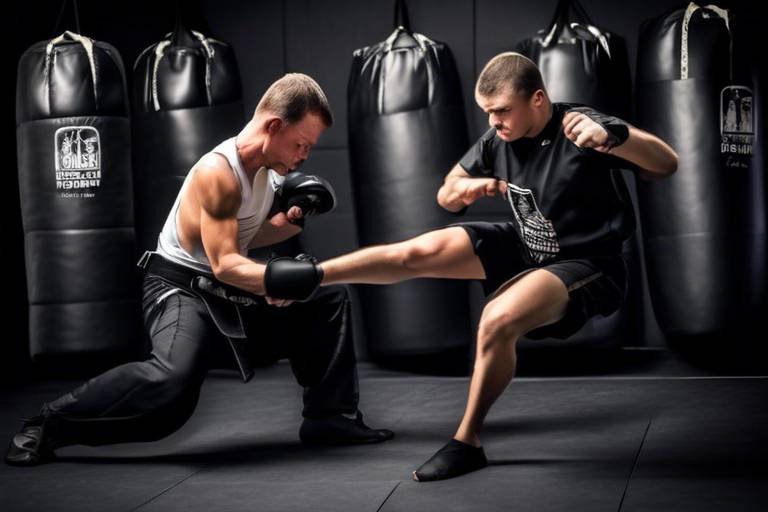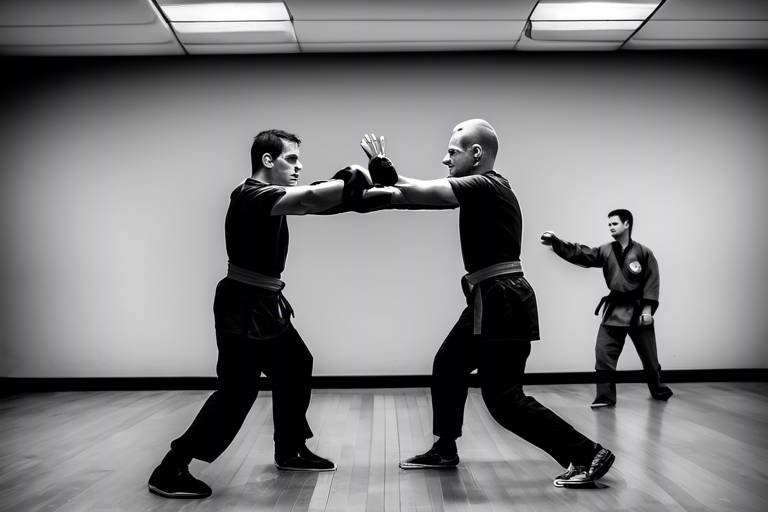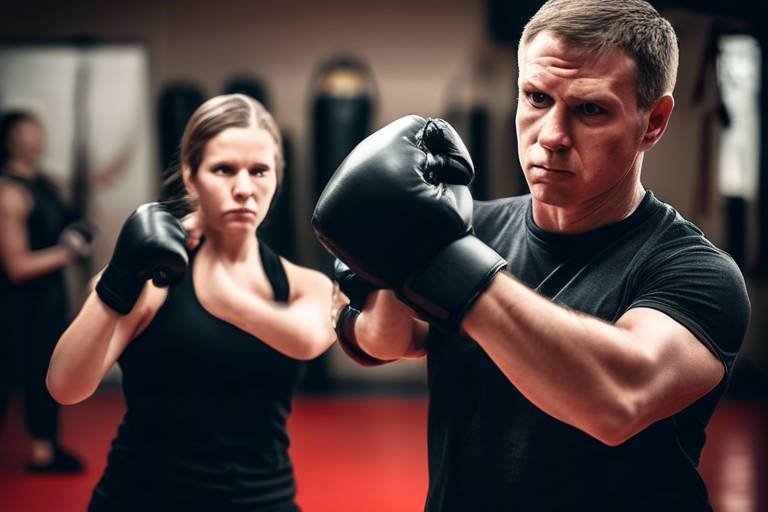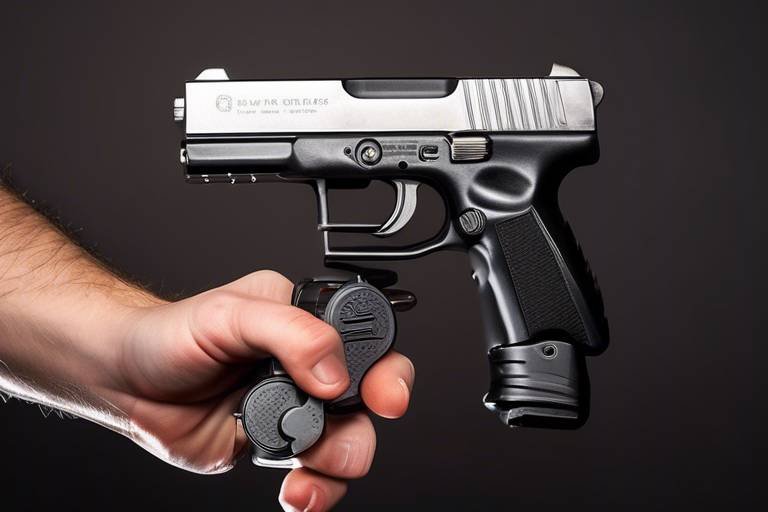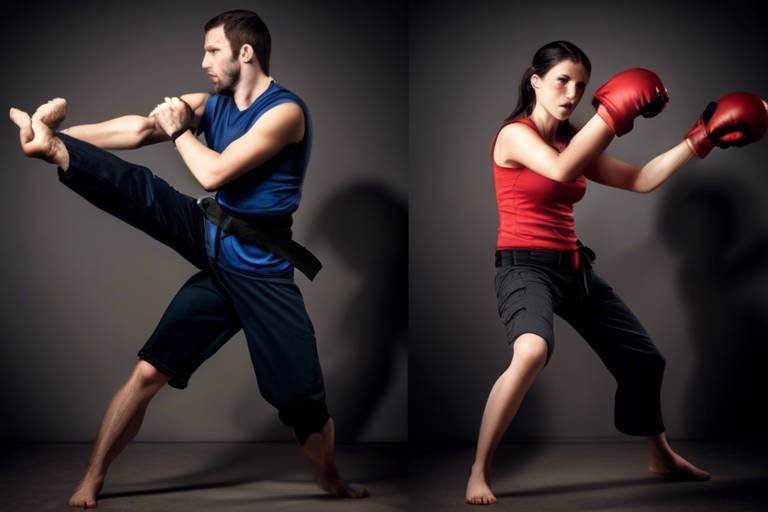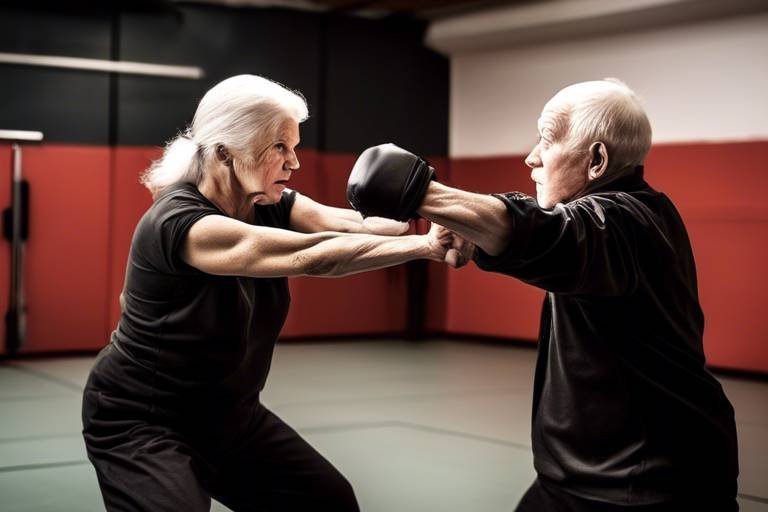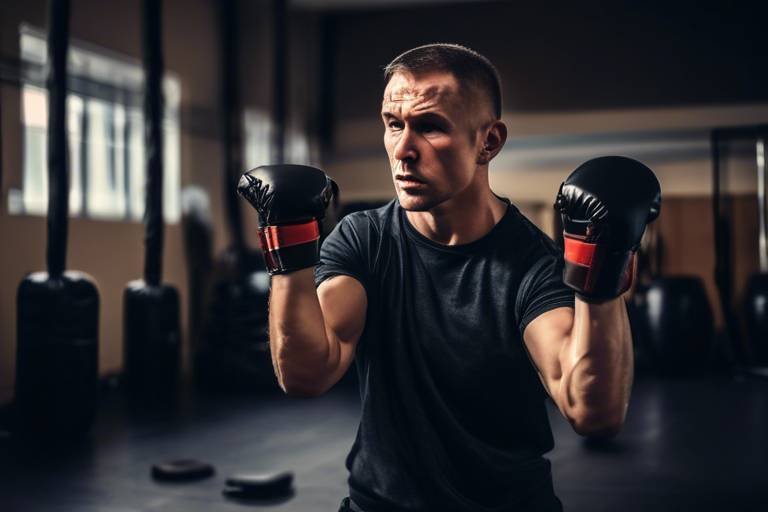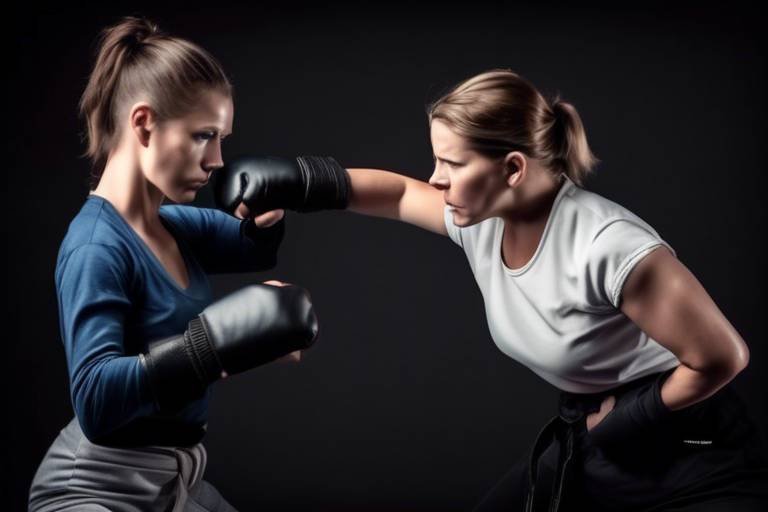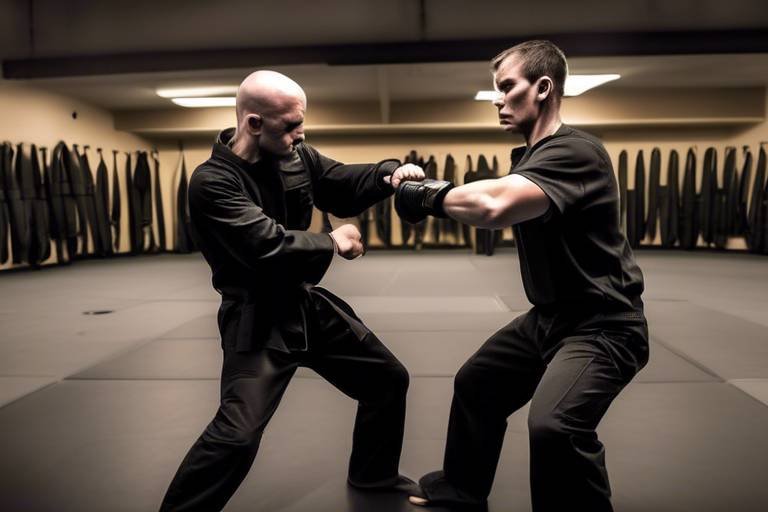Training Routines for Improving Self Defense Techniques
Self-defense is more than just learning a few moves; it's about empowering yourself with the skills and confidence to handle potentially dangerous situations. Whether you're a beginner or have some experience, establishing a solid training routine is essential for honing your self-defense techniques. In this article, we'll explore various training routines designed to enhance your self-defense skills, focusing on techniques, drills, and practices that can empower you in real-life situations.
Imagine walking down the street and suddenly finding yourself in a precarious situation. Your heart races, and your mind is flooded with questions. What do you do? How do you react? This is where effective training comes into play. By incorporating specific routines into your practice, you can prepare yourself mentally and physically. The goal is to not only learn how to defend yourself but to feel confident and capable in any circumstance. Throughout this article, we will delve into various aspects of self-defense training, ensuring that you have a comprehensive understanding of how to protect yourself.
So, let's get started on this journey to becoming more adept at self-defense. From understanding the fundamentals to mastering essential techniques, each section will build upon the last, creating a well-rounded approach to self-defense training. By the end of this article, you'll have a treasure trove of knowledge at your fingertips, ready to take your self-defense skills to the next level.
Before diving into specific routines, it's essential to grasp the basic principles of self-defense. Understanding the fundamentals lays a strong foundation for effective training. Self-defense is not just about physical strength; it's about awareness, strategy, and the ability to remain calm under pressure. Knowing when to engage and when to escape is crucial. This section covers key concepts such as situational awareness, the importance of de-escalation, and understanding the legal implications of self-defense.
In this section, we highlight the most critical self-defense techniques that everyone should learn. These techniques can significantly increase personal safety in various situations. By mastering these skills, you’ll be better equipped to handle potential threats. Remember, the objective is to protect yourself, not to engage in a fight. The techniques we will discuss include striking, defensive maneuvers, and effective escape strategies.
Striking techniques are vital in self-defense. This part focuses on effective punches, kicks, and elbow strikes that can help fend off attackers quickly and efficiently. Think of your body as a weapon; when trained correctly, it can deliver powerful strikes that can deter an assailant. Key striking techniques include:
- Punches: Straight punches, hooks, and uppercuts.
- Kicks: Front kicks, roundhouse kicks, and side kicks.
- Elbow Strikes: Close-range strikes that can be devastating.
Knowing where to strike can make a difference. This section discusses vulnerable areas of the body that can be targeted for maximum impact during a self-defense encounter. Aim for areas such as:
- Eyes: Blinding an attacker can provide a crucial moment to escape.
- Nose: A well-placed strike can cause significant pain and disorientation.
- Throat: A strike here can incapacitate an attacker temporarily.
- Groin: A classic target that can effectively deter an assailant.
Power and precision are crucial for effective striking. Here, we explore drills to enhance strength and accuracy in delivering self-defense strikes. Regular practice with a focus on technique can help build muscle memory, allowing you to react instinctively when needed. Shadow boxing, heavy bag training, and partner drills can all contribute to improving your striking capabilities.
Defensive maneuvers are equally important. This section covers techniques for evading attacks and protecting oneself from harm, emphasizing the importance of awareness and agility. Learning how to dodge, block, and counterattack can significantly increase your chances of escaping a dangerous situation unharmed.
Sparring is a practical way to apply self-defense techniques in a controlled environment. This section discusses the benefits of sparring and how to safely integrate it into training routines. Engaging in sparring sessions helps simulate real-life scenarios, allowing you to practice your skills under pressure. It also builds confidence and helps you understand timing and distance.
Choosing the right sparring partner is crucial for effective training. It's essential to find someone with a similar skill level who can challenge you without compromising safety. A good partner will push you to improve while also ensuring that both of you remain safe during practice.
Establishing clear goals for sparring sessions can enhance learning. Here, we discuss how to set achievable objectives to track progress and improve self-defense skills. Whether it's focusing on specific techniques or working on reaction times, having defined goals can help you stay motivated and measure your improvement.
Mental resilience is key in self-defense situations. This section emphasizes the importance of mental training and strategies to develop confidence and quick decision-making skills under pressure. Remember, self-defense is not just physical; it's also a mental game.
Visualization can enhance performance in self-defense. This part explores methods to mentally rehearse scenarios, helping individuals prepare for real-life confrontations. By visualizing yourself successfully defending against an attack, you can build confidence and reduce anxiety.
Managing stress is vital during self-defense situations. Here, we discuss techniques to stay calm and focused, allowing for better responses in high-pressure environments. Techniques such as deep breathing, mindfulness, and positive affirmations can help keep your mind clear and your reactions sharp.
Q: How long does it take to become proficient in self-defense?
A: The timeline varies for each individual, but consistent practice over several months can lead to noticeable improvement.
Q: Do I need to be physically fit to learn self-defense?
A: While fitness can enhance your performance, self-defense techniques can be adapted for individuals of all fitness levels.
Q: Can self-defense techniques be learned online?
A: Yes, many resources are available online, but it's recommended to practice under the guidance of a qualified instructor for safety and effectiveness.

Understanding Self Defense Fundamentals
Before we jump into the nitty-gritty of self-defense routines, it's crucial to grasp the fundamentals that underpin effective self-defense. Think of these principles as the bedrock upon which your skills will be built. Just like a house needs a solid foundation to stand tall, your self-defense capabilities require a strong understanding of its core concepts. So, what are these fundamentals? Let's break them down.
First and foremost, awareness is your best friend. Being aware of your surroundings can mean the difference between avoiding a confrontation and being caught off guard. Imagine walking into a crowded room; instead of just focusing on your phone, take a moment to scan the area. Are there exits? Who seems suspicious? This level of awareness helps you anticipate potential threats before they escalate.
Next up is the concept of de-escalation. Not every situation requires physical confrontation. Sometimes, the best defense is to diffuse a situation verbally. Picture yourself in a heated argument; if you can calmly communicate and resolve the issue without resorting to violence, you not only keep yourself safe but also demonstrate maturity and control. This is a skill that takes practice but is incredibly valuable.
Another fundamental aspect is understanding the legal implications of self-defense. Knowing when and how you can legally defend yourself can protect you from serious consequences. For instance, in many jurisdictions, you are allowed to use reasonable force to protect yourself, but what constitutes "reasonable" can vary widely. It's essential to familiarize yourself with the laws in your area to ensure that your actions are justified.
Lastly, physical fitness plays a significant role in self-defense. While you don't need to be a bodybuilder, being in good shape can enhance your agility, strength, and endurance—key factors in a self-defense scenario. Regular exercise not only prepares your body but also sharpens your mind, making you more alert and responsive. So, whether it’s jogging, yoga, or martial arts, find an activity that keeps you moving and engaged.
In summary, understanding self-defense fundamentals is about more than just learning how to throw a punch or execute a kick. It’s a holistic approach that combines awareness, communication, legal knowledge, and physical fitness. By integrating these elements into your training, you’re setting yourself up for success in real-life situations. Now that we have a solid foundation, let’s move on to the essential techniques that will further empower you in self-defense scenarios.
- What is the most important aspect of self-defense? Awareness is crucial; it helps you avoid dangerous situations before they escalate.
- Can self-defense techniques be learned by anyone? Absolutely! With practice and dedication, anyone can learn effective self-defense techniques.
- Is physical fitness necessary for self-defense? While not mandatory, being physically fit can greatly enhance your self-defense capabilities.
- What should I do if I find myself in a dangerous situation? Try to remain calm, assess your surroundings, and if possible, de-escalate the situation before resorting to physical defense.

Essential Techniques for Self Defense
When it comes to self-defense, having a solid understanding of essential techniques can be the difference between safety and danger. It's not just about brute strength; it's about using your body effectively and knowing how to react in various situations. Imagine being in a tight spot where every second counts—what techniques can you rely on? This section will delve into the most critical self-defense techniques that everyone should learn, ensuring that you feel empowered and ready to face any challenge that comes your way.
First and foremost, let's talk about striking techniques. These are fundamental in self-defense scenarios, allowing you to create space between you and an attacker. Effective punches, kicks, and elbow strikes can fend off aggressors quickly and decisively. Think of striking techniques as your first line of defense; they are your voice when words fail. For example, a well-placed jab can disrupt an attacker's momentum, giving you a chance to escape. Here are some essential striking techniques to consider:
- Punches: Straight punches, hooks, and uppercuts can be highly effective when executed with speed and precision.
- Kicks: Front kicks and roundhouse kicks are powerful tools that can incapacitate an attacker from a distance.
- Elbow Strikes: In close quarters, elbow strikes can be devastating and allow for quick follow-up actions.
Next, we need to address defensive maneuvers. It's not enough to strike; you must also know how to evade attacks. Being aware of your surroundings and anticipating an attack is crucial. Techniques such as ducking, weaving, and sidestepping can help you avoid incoming strikes while positioning yourself for a counterattack. Think of these maneuvers as a dance; the more fluid and aware you are, the better you can navigate the chaos of a confrontation.
Moreover, understanding target areas for strikes is vital. Knowing where to strike can significantly amplify the effectiveness of your techniques. Vulnerable areas of the body, such as the eyes, throat, solar plexus, and groin, can be targeted for maximum impact. These areas are sensitive and can incapacitate an attacker, giving you the upper hand. Here's a quick overview of these target areas:
| Target Area | Effect |
|---|---|
| Eyes | Temporarily blinds the attacker, allowing for escape. |
| Throat | Can cause difficulty breathing, creating an opportunity to flee. |
| Solar Plexus | Disrupts breathing and can incapacitate an attacker. |
| Groin | Causes severe pain, allowing for a quick getaway. |
Lastly, let’s discuss developing power and precision in your strikes. A powerful strike is ineffective if it lacks accuracy. To enhance both strength and precision, engage in drills that focus on hitting targets. Shadowboxing, using heavy bags, or practicing with a partner can improve your striking skills. Think of this training as honing a skill; the more you practice, the more natural it becomes. You wouldn’t want to throw a baseball without first learning how to pitch, right? The same applies to self-defense techniques.
In conclusion, mastering essential self-defense techniques involves a combination of striking, evading, and targeting specific areas of the body. By focusing on these elements, you empower yourself to react effectively in real-life situations. Remember, self-defense is not just about physical strength; it’s about being prepared, aware, and confident in your abilities.

Striking Techniques
When it comes to self-defense, are your first line of defense. Imagine being in a situation where you need to protect yourself; the ability to deliver a quick, powerful strike can make all the difference. Striking isn't just about brute force; it’s about technique, speed, and precision. Whether you're throwing a punch or delivering a kick, mastering these techniques can empower you and enhance your confidence in potentially dangerous situations.
One of the most fundamental aspects of striking is understanding how to use your body effectively. Proper stance and body mechanics are crucial. You want to ensure that your feet are shoulder-width apart, knees slightly bent, and your weight evenly distributed. This position not only provides balance but also allows for explosive movements. Think of your body as a coiled spring—when you release that energy, it should be directed toward your target with maximum impact.
Now, let's delve into some essential striking techniques that everyone should know. Here are a few key strikes that can be particularly effective:
- Punches: A well-executed punch can incapacitate an attacker. Focus on jabs, crosses, and hooks, as they can be delivered quickly and with power.
- Kicks: Kicking can create distance between you and an assailant. Front kicks, roundhouse kicks, and side kicks are great options to keep attackers at bay.
- Elbow Strikes: In close quarters, elbow strikes can be incredibly effective. They are short-range strikes that can deliver devastating force.
In addition to knowing the techniques, it’s vital to practice them regularly. Repetition builds muscle memory, allowing you to react instinctively under pressure. Consider incorporating these striking drills into your training routine:
| Drill | Description | Frequency |
|---|---|---|
| Punching Bag Work | Practice various punches on a heavy bag to build power and accuracy. | 3 times a week |
| Shadow Boxing | Visualize an opponent and practice your strikes in the air to improve technique. | Daily |
| Partner Drills | Work with a partner to practice strikes and defensive reactions. | 2 times a week |
Remember, knowing where to strike is just as important as how to strike. Targeting vulnerable areas of the body can maximize the effectiveness of your strikes. Common targets include:
- The nose
- The throat
- The solar plexus
- The knees
In conclusion, mastering striking techniques is a crucial component of self-defense training. By focusing on proper technique, practicing regularly, and knowing where to target your strikes, you can significantly enhance your ability to protect yourself in real-life situations. So, gear up, get out there, and start honing those skills—you never know when they might come in handy!

Target Areas for Strikes
When it comes to self-defense, knowing where to strike can make a world of difference. It's not just about throwing a punch or a kick; it's about targeting the most vulnerable areas of an attacker's body to maximize your chances of escaping a dangerous situation. Think of it like aiming for the bullseye in archery—the closer you get to the center, the more impact you have. Here are some key target areas to focus on:
- Eyes: A quick jab or swipe to the eyes can temporarily blind an attacker, giving you precious seconds to escape.
- Nose: A solid strike to the nose can cause pain and disorientation, making it harder for the attacker to continue their advance.
- Throat: A well-placed strike to the throat can incapacitate an assailant, as it disrupts their ability to breathe.
- Solar Plexus: Hitting this area can knock the wind out of someone, leaving them gasping for air and unable to pursue you.
- Groin: A kick to the groin is often a go-to move in self-defense, as it targets an area that is universally sensitive.
- Knees: Striking the knees can destabilize an attacker, making it difficult for them to maintain balance and control.
Understanding these target areas allows you to strike with intention and effectiveness. However, it's not enough to just know where to hit; you also need to practice your aim and technique. Drills that focus on accuracy, such as hitting pads or bags, can help you develop the muscle memory needed to react swiftly in a real-life scenario. Remember, in self-defense, every second counts, and having the ability to strike effectively can mean the difference between safety and danger.
In conclusion, as you train in self-defense, make sure to incorporate these target areas into your routine. Visualize yourself executing these strikes effectively, and practice them until they become second nature. The more prepared you are, the more confident you will feel in your ability to defend yourself when it matters most.
Q1: What is the most effective target area for self-defense strikes?
A1: While all target areas are important, the eyes and groin are often considered the most effective due to their sensitivity and the immediate incapacitation they can cause.
Q2: How can I improve my striking accuracy?
A2: Regular practice with focus mitts, bags, or during sparring sessions can significantly enhance your striking accuracy. Consider working with a partner to refine your technique.
Q3: Is it necessary to aim for vulnerable areas in self-defense?
A3: Yes, targeting vulnerable areas increases your chances of successfully defending yourself and escaping a dangerous situation. It’s about using your skills effectively.

Developing Power and Precision
This article explores various training routines designed to enhance self-defense skills. We will discuss different techniques, drills, and practices to empower individuals in real-life situations.
Before diving into specific routines, it's essential to grasp the basic principles of self-defense. This section covers key concepts to build a strong foundation for effective training.
This section highlights the most critical self-defense techniques that everyone should learn. Understanding these techniques can significantly increase personal safety in various situations.
Striking techniques are vital in self-defense. This part focuses on effective punches, kicks, and elbow strikes that can help fend off attackers quickly and efficiently.
Knowing where to strike can make a difference. This section discusses vulnerable areas of the body that can be targeted for maximum impact during a self-defense encounter.
When it comes to self-defense, power and precision are two of the most important attributes you can develop. Think of it like a well-tuned engine; if one part isn’t working correctly, the entire system suffers. To effectively defend yourself, you need to deliver strikes that are not only strong but also accurate. This requires a combination of strength training and technique refinement.
One effective way to develop power is through targeted strength training. Exercises such as squats, deadlifts, and bench presses help build the muscle groups that contribute to powerful strikes. However, lifting weights alone isn’t enough. You need to incorporate dynamic movements that mimic the actions you'll perform in a self-defense scenario. For example, using medicine balls for rotational throws can simulate the twisting motion of a punch.
In addition to strength training, practicing precision drills is essential. Here are a few drills to consider:
- Shadow Boxing: This involves practicing your strikes in the air, focusing on form and technique without a target. It helps build muscle memory.
- Focus Mitts: Working with a partner who holds focus mitts allows you to practice striking with accuracy. Aim for specific targets on the mitts to enhance your precision.
- Heavy Bag Training: Hitting a heavy bag not only builds power but also helps you gauge the impact of your strikes. Pay attention to your form and adjust as necessary.
Incorporating these exercises into your routine can help you develop the necessary power and accuracy for effective self-defense. Remember, it’s not just about hitting hard; it’s about hitting smart. Always focus on your technique to ensure that your strikes land where they can do the most good.
Sparring is a practical way to apply self-defense techniques in a controlled environment. This section discusses the benefits of sparring and how to safely integrate it into training routines.
Choosing the right sparring partner is crucial for effective training. This part provides tips on selecting someone who can help improve techniques while ensuring safety.
Establishing clear goals for sparring sessions can enhance learning. Here, we discuss how to set achievable objectives to track progress and improve self-defense skills.
Mental resilience is key in self-defense situations. This section emphasizes the importance of mental training and strategies to develop confidence and quick decision-making skills under pressure.
Visualization can enhance performance in self-defense. This part explores methods to mentally rehearse scenarios, helping individuals prepare for real-life confrontations.
Managing stress is vital during self-defense situations. Here, we discuss techniques to stay calm and focused, allowing for better responses in high-pressure environments.
- What is the best way to start self-defense training? Begin with basic techniques and gradually incorporate more advanced skills as you become comfortable.
- How often should I practice self-defense techniques? Consistency is key; aim for at least two to three sessions per week to build muscle memory and confidence.
- Can self-defense training help with mental resilience? Absolutely! Self-defense training not only improves physical skills but also boosts mental toughness and confidence.

Defensive Maneuvers
When it comes to self-defense, are your first line of protection. Think of them as your safety net; they allow you to evade attacks and create space between you and a potential threat. The art of dodging, weaving, and blocking isn’t just about physical movement; it’s about being aware of your surroundings and anticipating an attack before it happens. Imagine you’re a matador in a bullring, gracefully sidestepping danger while maintaining your composure. This is the essence of effective defensive maneuvers.
One of the most crucial aspects of defensive maneuvers is awareness. Being aware of your surroundings can help you detect potential threats early on. This means keeping your head up, scanning the area, and being conscious of the people around you. It’s like being a hawk, always alert and ready to react. When you spot a potential attacker, your body can instinctively prepare to respond. But what happens when an attack is imminent? This is where your defensive techniques come into play.
There are several key defensive maneuvers that every individual should practice regularly. These include:
- Blocking: Using your arms and hands to deflect incoming strikes.
- Ducking: Lowering your body to avoid high strikes.
- Weaving: Moving your head and upper body to dodge punches.
- Footwork: Shifting your position to avoid being cornered.
Each of these techniques serves a specific purpose in a self-defense scenario. For instance, blocking is fundamental; it allows you to absorb the force of an attack while minimizing damage. Think of it as putting up a shield in front of you. On the other hand, ducking and weaving can be compared to dancing; it requires rhythm and timing to avoid strikes effectively. When practiced together, these maneuvers can create a seamless flow that keeps you one step ahead of your attacker.
Moreover, agility plays a significant role in executing these defensive techniques. A well-timed dodge or block can turn the tide of a confrontation. To enhance your agility, consider incorporating specific drills into your training routine. For example, practicing footwork drills can help improve your speed and reaction time. You might want to set up a series of cones and practice moving in different directions quickly. This not only builds muscle memory but also conditions your body to respond instinctively.
As you become more comfortable with these maneuvers, it’s essential to integrate them into your overall self-defense training. This means practicing them in realistic scenarios, perhaps through controlled sparring sessions. Sparring allows you to test your defensive maneuvers against a live opponent, which can reveal areas for improvement. It’s like a rehearsal before the big performance—essential for building confidence and refining your skills.
Lastly, remember that defensive maneuvers are not just physical techniques; they also require a strong mental component. Staying calm under pressure is crucial. When faced with a threat, panic can cloud your judgment, making it harder to execute your defensive strategies. Therefore, mental training, such as visualization and stress management techniques, should be part of your routine. Picture yourself successfully dodging an attack or blocking a strike; these mental rehearsals can significantly boost your confidence and readiness.
- What should I do if I can't evade an attack? Focus on blocking or redirecting the attack to minimize damage.
- How can I improve my awareness in public spaces? Practice scanning your environment regularly and being mindful of your surroundings.
- Is sparring necessary for self-defense training? Yes, sparring provides practical experience and helps you apply defensive maneuvers under pressure.

Incorporating Sparring into Training
Sparring is not just a fun way to blow off steam; it's a critical component of self-defense training that allows practitioners to apply their skills in a controlled setting. Think of sparring as a dress rehearsal for a play—you wouldn't want to go on stage without practicing your lines! Similarly, sparring helps you to become comfortable with your techniques, allowing you to react instinctively when it really counts. By simulating real-life scenarios, you can develop a better understanding of timing, distance, and movement, which are essential in a self-defense situation.
One of the most significant benefits of sparring is that it teaches you to remain calm under pressure. When you're facing an opponent, your heart races, and adrenaline kicks in. This is where the real learning happens. You learn to make quick decisions, adapt your strategies on the fly, and respond to unpredictable situations. It’s like playing a game of chess, where every move counts, and you need to anticipate your opponent's next step. The more you spar, the more you train your brain to handle high-pressure situations effectively.
However, it's essential to approach sparring with a clear understanding of its purpose. Here are some key points to keep in mind:
- Safety First: Always prioritize safety. Use appropriate protective gear, such as gloves, mouthguards, and headgear, to minimize the risk of injury. Remember, the goal is to train, not to hurt each other.
- Controlled Environment: Sparring should be conducted in a controlled environment, preferably under the supervision of an experienced instructor. This ensures that everyone involved knows the rules and objectives, making the experience more beneficial.
- Focus on Technique: While it might be tempting to go all out, focus on applying the techniques you've learned rather than just trying to win. This mindset will help you improve faster and build a solid foundation for your self-defense skills.
Integrating sparring into your routine can be a game-changer. It not only enhances your physical skills but also builds your mental resilience. As you spar, you learn to read your opponent's movements, which sharpens your awareness—an invaluable asset in any self-defense scenario. Just like a boxer learns to anticipate punches, you can train your mind to recognize potential threats and respond accordingly.
In summary, sparring is an essential part of self-defense training that offers numerous benefits, from improving your techniques to building mental toughness. By incorporating sparring into your routine, you prepare yourself not just physically, but also mentally for real-world encounters. So, lace up those gloves and get ready to take your self-defense skills to the next level!
Q: How often should I spar?
A: The frequency of sparring can vary based on your skill level and training goals. Beginners might start once a week, while more advanced practitioners may spar multiple times a week to refine their skills.
Q: What should I wear during sparring?
A: It's essential to wear protective gear, including gloves, mouthguards, and headgear, to ensure safety during sparring sessions.
Q: Can I spar with someone of a different skill level?
A: Yes, but it's crucial to ensure that both participants are aware of their skill levels and agree on the intensity of the sparring session. This ensures a safe and productive training experience.

Finding a Sparring Partner
Choosing the right sparring partner is like picking a dance partner; you want someone who complements your moves while pushing you to improve. A good sparring partner can make all the difference in your self-defense training, providing you with realistic scenarios and challenges that help sharpen your skills. So, how do you find that perfect match? First and foremost, look for someone who shares similar goals and experience levels. This ensures that both of you can benefit from the sessions without one person feeling overwhelmed or under-challenged.
It's also essential to consider the personality and attitude of your sparring partner. You want someone who is serious about training but also maintains a sense of fun and respect during practice. A sparring partner should be someone who encourages you to push your limits while keeping safety as a top priority. Remember, the goal is to learn and grow, not to prove who is the toughest. Communication is key; make sure to discuss your training objectives, comfort levels, and any specific techniques you want to focus on.
To help you in your search, here are some tips for finding a suitable sparring partner:
- Join a local martial arts class: Many studios have a community of practitioners looking for partners.
- Attend self-defense workshops: These events often allow you to meet like-minded individuals eager to train.
- Utilize social media: Platforms like Facebook and Instagram can connect you with local training groups.
- Ask friends or family: Sometimes the best partners are those close to you who are willing to learn.
Once you've found a potential partner, make sure to start with light sparring sessions. This allows both of you to gauge skill levels and adjust your intensity accordingly. It's crucial to establish ground rules before sparring, such as targeting areas, the level of contact, and safe words to use if someone feels uncomfortable. This not only ensures safety but also builds trust between partners, making the training environment more effective and enjoyable.
Finally, don’t be afraid to switch partners occasionally. Different sparring partners can expose you to varied techniques and styles, enriching your overall training experience. Each session is an opportunity to learn and grow, so embrace the journey and enjoy the process of becoming a more skilled self-defender!

Setting Sparring Goals
Setting sparring goals is a crucial step in enhancing your self-defense skills. Just like any athlete would not step onto the field without a game plan, you shouldn’t enter a sparring session without clear objectives. These goals not only help you stay focused but also provide a roadmap to measure your progress. Think of it as having a destination in mind when you're on a journey; without it, you may end up wandering aimlessly.
When establishing sparring goals, consider the following aspects:
- Skill Improvement: Focus on specific techniques you want to master. For instance, if you struggle with your jab, set a goal to practice it consistently during sparring sessions.
- Defensive Strategies: Aim to incorporate defensive maneuvers into your sparring. This could mean setting a target for how many times you can successfully evade an attack.
- Endurance and Stamina: Sparring is physically demanding. Set goals to increase your stamina, such as lasting longer in rounds or recovering faster between them.
Remember, it’s essential to keep your goals S.M.A.R.T: Specific, Measurable, Achievable, Relevant, and Time-bound. For example, instead of saying, “I want to get better,” you could say, “I want to land five effective strikes in each sparring round by the end of the month.” This clarity not only motivates you but also allows you to track your progress effectively.
Moreover, as you set these goals, don’t forget to communicate with your sparring partner. Sharing your objectives can create a supportive environment where both of you can work towards improvement. For instance, if you want to focus on counter-attacks, your partner can adjust their approach to help you practice this skill. It’s all about collaboration and mutual growth.
As you progress, revisit and revise your goals regularly. This practice ensures that you are continually challenged and engaged, preventing stagnation in your training. Just like climbing a mountain, you may need to reassess your route as you reach new heights. Celebrate your achievements, no matter how small, because each step forward is a victory in your journey towards mastering self-defense.
1. How often should I set sparring goals?
It's a good idea to set new goals every month or after every few sparring sessions. This keeps your training fresh and challenging.
2. Can I have multiple sparring goals at once?
Absolutely! Just ensure they are manageable. Focus on a few key areas to avoid feeling overwhelmed.
3. What if I don’t achieve my sparring goals?
Don’t be discouraged! Use it as a learning opportunity. Analyze what went wrong and adjust your approach for next time.
4. How can I track my sparring progress?
Keep a training journal where you note down your goals, achievements, and areas for improvement after each sparring session.

Building Mental Resilience
When it comes to self-defense, physical skills are only part of the equation. Mental resilience plays a crucial role in how effectively you can respond in high-pressure situations. Imagine being in a scenario where your heart is racing, and your mind is clouded with fear. Without mental fortitude, even the best training can fall short. So, how can you build this mental strength? Let’s dive into some strategies that can help you stay calm and collected when it matters most.
First, it's important to understand that mental resilience is not something you either have or don’t have. It’s a skill that can be developed through practice and dedication. One effective way to enhance this skill is through visualization techniques. This involves mentally rehearsing various self-defense scenarios, allowing you to prepare for the unexpected. Picture yourself facing an attacker: what would you do? How would you react? By visualizing these situations, you train your mind to respond more effectively when faced with real threats.
Visualization can be as simple as closing your eyes and imagining a confrontation. Picture yourself using specific techniques you’ve learned, such as striking or evading. The more vivid your mental imagery, the better prepared you’ll be. You might even consider creating a visualization routine that you practice regularly, perhaps right before your training sessions or even at home. This can help reinforce your skills and build confidence.
Another vital aspect of building mental resilience is stress management. In high-stakes situations, stress can be overwhelming, clouding your judgment and impairing your physical abilities. Therefore, learning to manage stress is essential. Techniques such as deep breathing, meditation, or even physical exercise can help calm your mind and body. For instance, when you feel stress creeping in, try taking a few deep breaths: inhale deeply through your nose, hold for a moment, and exhale slowly through your mouth. This simple practice can help ground you and bring clarity to your thoughts.
Additionally, consider incorporating mindfulness practices into your routine. Mindfulness helps you stay present and aware, which is crucial during self-defense scenarios. By focusing on the here and now, you can reduce anxiety about what might happen and instead concentrate on what you can control. This could be as simple as paying attention to your surroundings during a walk or practicing meditation for a few minutes each day.
To further enhance your mental resilience, it’s beneficial to embrace a growth mindset. This means viewing challenges as opportunities for growth rather than obstacles. When you make mistakes during training, instead of getting discouraged, analyze what went wrong and how you can improve. This mindset shift not only boosts your confidence but also prepares you to handle unexpected situations with a more adaptable approach.
Finally, surrounding yourself with a supportive community can significantly impact your mental resilience. Engaging with fellow practitioners who share similar goals can provide motivation and encouragement. You might find it helpful to join a self-defense class or a local martial arts group. In these settings, you can share experiences, learn from one another, and build a network of support that reinforces your mental strength.
In summary, building mental resilience is a multifaceted process that involves visualization, stress management, mindfulness, a growth mindset, and community support. By integrating these strategies into your self-defense training, you can enhance your ability to respond effectively in challenging situations. Remember, the mind is a powerful tool; when trained properly, it can be your greatest ally in self-defense.
- What is mental resilience? Mental resilience refers to the ability to adapt to stressful situations and bounce back from challenges.
- How can visualization help in self-defense? Visualization helps prepare your mind for real-life confrontations by mentally rehearsing scenarios and responses.
- What are some stress management techniques? Techniques include deep breathing, meditation, and physical exercise to calm the mind and body.
- How does a growth mindset benefit self-defense training? A growth mindset encourages viewing challenges as opportunities to learn, which can enhance overall performance.

Visualization Techniques
When it comes to self-defense, the mind is just as important as the body. are powerful tools that can help you prepare for and excel in real-life confrontations. Imagine being in a high-pressure situation—your heart races, your palms sweat, and every instinct tells you to panic. But what if I told you that by mentally rehearsing scenarios ahead of time, you could train your mind to remain calm and focused? That's the essence of visualization.
Visualization is like a mental rehearsal. It allows you to see yourself successfully navigating through potential threats and challenges before they even occur. This practice can significantly enhance your confidence and decision-making skills. Think of it as a movie playing in your mind, where you are the hero who always comes out on top. The more you visualize these scenarios, the more familiar they become, which can drastically reduce anxiety when facing real-life situations.
To effectively use visualization techniques, consider the following steps:
- Find a Quiet Space: Choose a tranquil environment where you can concentrate without distractions.
- Close Your Eyes: This helps you to focus inward and eliminate outside noise.
- Breathe Deeply: Take slow, deep breaths to calm your mind and body.
- Visualize Specific Scenarios: Picture yourself in various self-defense situations, such as being approached by an attacker or needing to escape a dangerous environment.
- Engage All Your Senses: Don’t just see the scenario; hear the sounds, feel the sensations, and even smell the environment. This makes the experience more vivid.
- Focus on Positive Outcomes: Visualize not just surviving, but thriving—escaping unharmed, defending yourself effectively, or even seeking help.
Incorporating these techniques into your training routine can be incredibly beneficial. Not only does visualization prepare you mentally, but it also helps in building muscle memory. When you visualize a technique, your brain sends signals to your body that can enhance your physical response when the time comes. It's like programming your brain to act instinctively, so when faced with a real threat, your body knows exactly what to do.
Furthermore, visualization can help you tackle various emotional responses associated with self-defense, such as fear or hesitation. By repeatedly envisioning yourself successfully handling confrontations, you can reshape your mindset. This mental conditioning can lead to quicker, more decisive actions in critical moments. Remember, self-defense isn't just about physical strength; it's about mental fortitude as well.
To sum it up, visualization techniques are a crucial component of self-defense training. They empower you to face potential threats with confidence and clarity. So, the next time you practice your self-defense moves, take a moment to visualize them in action. You might be surprised at how much it enhances your overall performance.
Q: How often should I practice visualization techniques?
A: Ideally, you should practice visualization daily or several times a week. Consistency is key to reaping the benefits.
Q: Can visualization replace physical training?
A: No, visualization should complement physical training, not replace it. Both mental and physical practices are essential for effective self-defense.
Q: What if I struggle to visualize scenarios?
A: If visualization feels challenging, start with simpler scenarios and gradually build complexity. You can also try guided visualization exercises or apps that help with this process.

Stress Management Strategies
When it comes to self-defense, the ability to manage stress can mean the difference between success and failure in a high-pressure situation. Imagine being confronted by an aggressor; your heart races, palms sweat, and your mind may go blank. This is where effective come into play, allowing you to remain calm and focused. One of the most powerful tools at your disposal is breathing techniques. Deep, controlled breaths can help lower your heart rate and clear your mind, enabling you to think clearly and react appropriately.
Another effective strategy is mindfulness meditation. By practicing mindfulness, you train your mind to stay present, which can significantly reduce anxiety. Picture yourself in a serene environment, focusing solely on your breath or the sounds around you. This practice can enhance your overall awareness, making you more alert to your surroundings, which is crucial in self-defense scenarios.
In addition, physical exercise plays a vital role in managing stress. Engaging in regular workouts not only strengthens your body but also releases endorphins, the natural mood lifters. Whether it's a brisk walk, a run, or a martial arts class, keeping your body active can significantly reduce stress levels. Consider incorporating a routine that includes not just physical training but also activities that bring you joy, such as dancing or yoga, to keep your stress in check.
Moreover, having a solid support system can alleviate stress. Surrounding yourself with friends and family who understand your self-defense journey can provide emotional support and encouragement. Sharing experiences and discussing fears can help normalize your feelings, making them easier to manage. Additionally, if you find yourself feeling overwhelmed, don't hesitate to seek professional help. A therapist can provide you with tailored strategies to cope with stress effectively.
Lastly, it’s essential to have a plan. Knowing what to do in a self-defense scenario can significantly ease anxiety. Practice scenarios through role-playing or visualization techniques, where you mentally rehearse your responses to potential threats. This preparation can create a sense of control, which naturally reduces stress. Remember, the goal is to transform anxiety into a focused energy that enhances your performance, rather than hinders it.
- What is the best way to manage stress during a self-defense situation? Practicing deep breathing and mindfulness can help maintain focus and calmness.
- How can physical exercise help with stress management? Regular exercise releases endorphins and improves overall mood, making it easier to handle stressful situations.
- Is it beneficial to talk about my fears with others? Yes, discussing your feelings with friends or a support group can help normalize your experiences and reduce stress.
- Can visualization really help in self-defense training? Absolutely! Visualization prepares your mind for real-life scenarios, making you more confident and ready to react.
Frequently Asked Questions
-
What are the basic principles of self-defense?
The basic principles of self-defense include awareness, avoidance, and effective response. Being aware of your surroundings helps you avoid potential threats. If confronted, knowing how to effectively respond can make all the difference in a dangerous situation.
-
What are some essential self-defense techniques everyone should learn?
Some essential techniques include striking (like punches and kicks), defensive maneuvers (such as blocking and evading), and grappling techniques. These skills can significantly enhance your ability to protect yourself in various scenarios.
-
How can I improve my striking power and precision?
Improving striking power and precision can be achieved through targeted drills, strength training, and practicing your techniques regularly. Focus on hitting the right target areas with speed and accuracy to maximize your effectiveness.
-
Why is sparring important in self-defense training?
Sparring is crucial because it allows you to apply techniques in a controlled environment, helping you understand timing, distance, and the unpredictability of an actual confrontation. It also builds confidence in your abilities.
-
How do I choose the right sparring partner?
Choosing the right sparring partner involves finding someone with a similar skill level who is committed to safe training. Look for someone who can challenge you while also prioritizing safety and mutual respect during sessions.
-
What role does mental resilience play in self-defense?
Mental resilience is vital as it helps you stay calm and make quick decisions under pressure. Developing this skill can enhance your ability to react effectively in stressful situations, making it a crucial part of your training.
-
Can visualization techniques really improve my self-defense skills?
Absolutely! Visualization techniques can enhance your performance by allowing you to mentally rehearse scenarios. This mental practice prepares you for real-life confrontations and helps instill confidence in your abilities.
-
What are some effective stress management strategies for self-defense situations?
Effective stress management strategies include deep breathing exercises, mindfulness techniques, and maintaining a positive mindset. These practices can help you stay focused and calm, allowing for better responses during high-pressure encounters.

